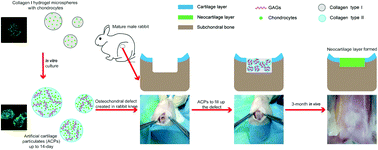Repair of osteochondral defects in a rabbit model with artificial cartilage particulates derived from cultured collagen-chondrocyte microspheres
Abstract
Tissue engineered cartilage has become a promising candidate for restoration of defective cartilage, but is normally associated with problems including limited tissue size, inferior mechanical properties, poor tissue homogeneity and integrative properties compared to the native cartilage. In this study, we utilised our recently developed microsphere culture technique to fabricate artificial cartilage particulates (ACPs) using collagen hydrogel microspheres with allogenic chondrocytes. These ACPs were used to repair rabbit osteochondral defects in vivo. The results demonstrated that the optimised ACPs showed better cartilage repair and integration into the host tissue. Moreover, the mechanical integrity of ACPs protected the tissue underneath and enhanced the subchondral bone formation. After 3 months of surgery, the subchondral bone volume had recovered to a similar level to the natural tissue. Together, these results suggested that the ACPs prepared using our microsphere culture technique show great potential for osteochondral repair in future clinical applications.



 Please wait while we load your content...
Please wait while we load your content...